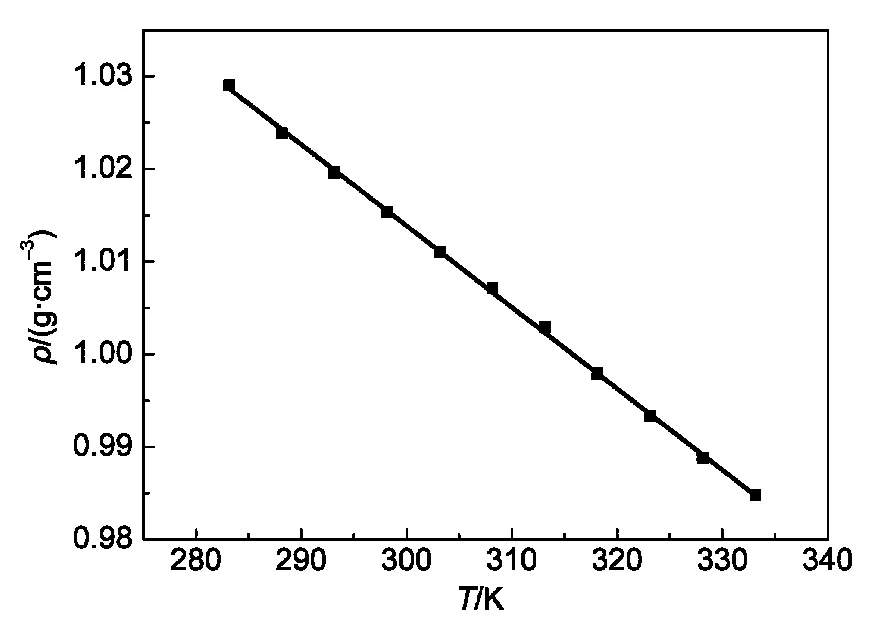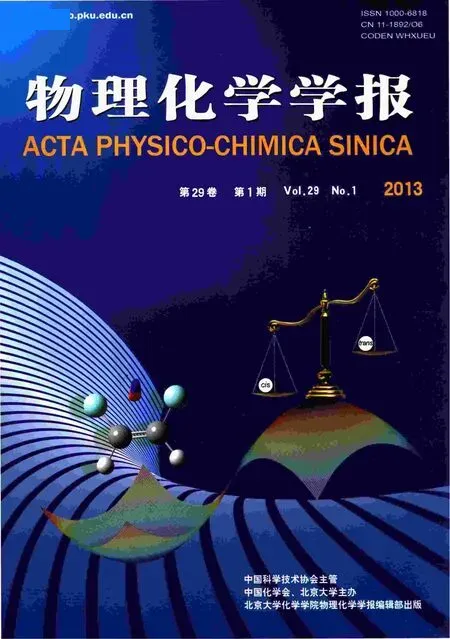质子型离子液体N,N-二甲基乙醇胺丙酸盐的密度、粘度及电导率
李长平 李 琢,3 邹本雪 刘青山,* 刘晓霞,*
(1大连大学环境与化学工程学院,辽宁大连 116622;2东北大学化学系,沈阳 110819;3大连海洋大学理学院,辽宁大连 116023)
1 Introduction
Nowadays,more and more attention has been paid to the pollution from fuel combustion exthaust.1-3So much emphasis has been put on the clean diesel fuels by most countries,especially the sulfur content.4-6As a conventional method,the hydrodesulfurization(HDS)is widely used for the removal of sulfur compounds in the petroleum refining industry.7However,the traditional extractants used for the desulfurization process are organic solvents,which are volatile and toxic.So,the finding of greener,more safe,and efficient novel extractants is necessary to replace the traditional ones.
Ionic liquids(ILs)have many advantages,such as low vapor pressure,thermal and chemical stability,designability,etc.8-11They are considered to be the green solvents that replace the volatile organic solvents.12,13In recent years,ILs applied for extraction desulfurization of diesel fuels have been widely studied.As the green solvents,the ILs can be designed,which provides us with more choice for the option of ILs.Nowadays the ILs used for desulfurization is mainly imidazole-based or pyridine-based ILs.The expensive materials become the main problems for the industrialization.At the same time,the viscosity of existing ILs is still very high,which is harmful for the dispersion and mass transfer.It is another problem for industrial application.So the development of novel ILs with cheap materials,low viscosity,and easily synthesis route is very urgent.
Recently,the authors found that protic ionic liquids(PILs)not only have the excellent physico-chemical properties of traditional ILs,but also have the unique advantages,such as high extraction efficiency,low cost,low viscosity,and easily recycling compared to traditional ILs.14The materials of the PILs are also cheap and the process of the synthesis is simple.At the same time,PILs are environmentally favorable because their anions are mostly composed of non-toxic anion such as organic acids.15-18PILs have become a potential greener desulfurization solvents.However,the lack of physico-chemical properties data of PILs has become a hinder for their future industrial application.
Herein,a PIL N,N-dimethylethanolammonium propionate(DMEOAP)was synthesized.And some important physicochemical properties such as density,viscosity,and conductivity were determined and discussed.The relationship of the density,viscosity,and conductivity was built in terms of the Walden rule.
2 Experimental
2.1 Materials
N,N-dimethylethanolamine(99%,Aladdin,China),Propionic acid(AR grade,Aladdin,China)was provided by Sigma-Aldrich.
2.2 Synthesis and characterization of the PIL DMEOAP
The PIL DMEOAP was synthesized and characterized according to our previous method.171H nuclear magnetic resonance(1H NMR)was used for determination of the PIL structure with dimethyl sulfoxide as the solvent,the other basic parameters are shown in Fig.S1(Supporting Information).No impurity was found in PIL from the1H NMR.The water content(mass fraction)is 486×10-6by a Cou-Lo Aquamax Karl Fischer moisture meter(v.10.06).The structure of the DMEOAP is listed as below:

Table 1 Experimental values of density(ρ),viscosity(η),conductivity(σ),and molar electrical conductivity(Λ)at pressure p=0.1 MPa and different temperatures
2.3 Density,viscosity,and conductivity measurements
The density,viscosity,and conductivity were determined according to a previous method at atmosphere.19,20The density was determined by a Westphal balance in the temperature range of 283.15-333.15 K within experimental error±0.0002 g·cm-3.The viscosity was determined using an Ostwald viscometer in the temperature range of 288.15-333.15 K and the uncertainties were estimated to be±1%.The conductivity was carried out on a MP522 conductivity instrument with the cell constants of 1 cm-1(the cell was calibrated with the aqueous KCl solution)in the temperature range of 283.15-333.15 K and the uncertainties were estimated to be±1%.The experimental values are listed in Table 1.
3 Results and discussion
From Table 1,the density and viscosity decrease with increasing the temperature.However,different from the density and viscosity,the conductivity shows the inverse trend shown in Fig.1.
3.1 Density
The density data versus temperature was fitted by following equation:


Fig.1 Density of PILDMEOAP as a function of temperature
where ρ is the density;A,B are fitting parameters.The fitted equation is ρ=1.2774-8.79×10-4T.The correlation coefficient is 0.999.
The thermal expansion coefficient,α,can be obtained by the lnρ versus T fitted according to a straight line.The fitting equation is below:

where b is an empirical constant,α is thermal expansion coefficient.The thermal expansion coefficient is 8.73×10-4K-1for the sample.
The molecular volume,Vm,can be calculated by the following equation:

where M is molar mass,N is Avogadro′s constant.The value of molecular volume,Vm,is 0.2670 nm3at 298.15 K.
The standard molar entropy can be estimated according to the following equation:21

The value is 362.4 J·K-1·mol-1for sample at 298.15 K.
The lattice energy,UPOT,was calculated according to the following equation:21

The lattice energy value is 468.2 kJ·mol-1at 298.15 K.The value is lower than that of melt salts.For example,the fused CsI22has the lowest lattice energy among the alkali halides and the value is 613 kJ·mol-1.This is the reason that the PIL can exist as liquid state at room temperature.
3.2 Molar conductivity
The molar conductivity data can be determined according to the following equation:

where Λ is the molar conductivity,σ is the conductivity.The molar conductivity values are listed in Table 1.
The molar conductivity,Λ,versus temperature,T,of the ILs can be fitted according to the following Vogel-Fulcher-Tamman(VFT)equation:

where Λ0,B are adjustable parameters.The fitting equation is Λ=29.23·exp(-598.7/(T-179.3)).The correlation coefficient is 0.99996.
3.3 Viscosity
Usually,the VFT equation was used for the fitting of the viscosity versus temperature according to the following equation:

where η is the viscosity;η0,B are fitting parameters.The fitting equation is η=0.0116·exp(1296.6/(T-140.5)).The correlation coefficient is 0.9998,which indicates that the VFT equation can be used for the viscosity fitting of PILs.Fig.2 shows the variation of the viscosity versus temperature.
According to the Arrhenius equation,the viscosity versus temperature can be described as follows:


Fig.2 Viscosity of PILDMEOAP as a function of temperature
where Eηis the activation energy for dynamic viscosity,η∞is the maximum electrical conductivity,and kBis the Boltzmann constant.
Recently,Vila et al.23have built the relationship of the VFT equation and Arrhenium equation for conductivity.Here,for dynamic viscosity,the VFT equation and Arrhenius equation can also be combined according to the discussion by Vila et al.23and the final version of VFT equation is:

here,η0=σ∞.The viscosity activation energy value is 111.9×10-3eV.
3.4 Conductivity
Usually,the VFT equation was also used for the fitting of the conductivity data versus temperature:

here σ0,B are adjustable parameters,B=Eη/kB.The fitting equation is σ=141.8·exp(-552.2/(T-182.8)).The correlation coefficient is more than 0.99996,which indicates that the VFT equation can be used for the viscosity fitting of PILs.Fig.3 shows the variation of the conductivity versus temperature.
According to the Arrhenius equation,the conductivity versus temperature can be described:

where Eais the activation energy,which indicates the energy needed for an ion to hop to a free hole,σ∞is the maximum electrical conductivity.
For conductivity,the VFT equation and Arrhenius equation can be combined according to the discussion by Vila et al.23and the final version of VFT equation is:

Fig.3 Conductivity of PIL DMEOAP as a function of temperature

Fig.4 Plots of lnη and lnσ versus 1/T for PILDMEOAP

here,σ0=σ∞and B=Eσ/kB.The electrical conductivity activation energy value is 47.65×10-3eV.
The lnη and lnσ vs T-1were plotted for PIL DMEOAP(see Fig.4).According to the Arrhenius equations(9)and(12),the lines should be the straight lines for viscosity and conductivity,however,the curves are not ideal straight lines in Fig.4(the broken straight lines are plotted on the curves).So,the viscosity and conductivity do not well follow the Arrhenius behavior according to the Arrhenius equation.
3.5 Walden product
According to the Walden rule,the molar conductivity and viscosity can be described according to the following equation:

where k is a temperature dependent constant.The variation of lgΛ versus lgη-1is shown in Fig.5 for DMEOAP and[Cnpy][NTf2](n=2,4,5).20Recently,the authors have studied molar conductivity and viscosity of the normal ILs[Cnpy][NTf2](n=2,4,5)using the same measurement.So,the ILs[Cnpy][NTf2](n=2,4,5)were chosen as the references with the desired PIL.The slope,α,was obtained and the value is 0.925 for DMEOAP.From Fig.5,the curve of PIL DMEOAP is under the ideal line,20the position of the ideal line is obtained using aqueous KCl solutions at high dilution.24It means that the PIL is also“subionic”.25The curve of PIL DMEOAP is also much lower than ILs[Cnpy][NTf2](n=2,4,5).20The probable reason for this is that PIL has more tendency of the lower ionic capability than the traditional pyridine based ILs.At the same time,its special accumulation structure would also account for this phenomenon.

Fig.5 Plot of lgΛ versus lgη-1 for PILDMEOAP and pyridinium-type ILs20
4 Conclusions
The density,viscosity,and conductivity of PIL were determined in the temperature range 283.15-333.15 K.The thermal expansion coefficient,molecular volume,standard molar entropy,and lattice energy of DMEOAP were estimated by the density values.The VFT equation can be used for the viscosity or conductivity fitting.The Arrhenius equation cannot be well used for the fitting of the viscosity or conductivity.The density,viscosity,and conductivity relationship can be set up according to the Walden rule.
Supporting Information∶The1H NMR spectrum of N,N-dimethylethanolammonium propionate has been included.This information is available free of charge via the internet at http://www.whxb.pku.edu.cn.
(1)Lissner,E.;Souza,W.;Ferrera,B.;Dupont,J.ChemSusChem 2009,10,962.
(2)Zhu,W.;Li,H.;Jiang,X.;Yan,Y.;Lu,J.;Xia,J.Energy Fuels 2007,21,2514.doi:10.1021/ef700310r
(3)Wang,S.Q.;Zhou,L.;Su,W.;Sun,Y.;Zhou,Y.P.AIChE J.2009,55,1872.doi:10.1002/aic.v55:7
(4)http://www.epa.gov/otaq/fuels/dieselfuels/index.htm,accessed March 2012.
(5)http://www.dieselnet.com/standards/eu/fuel.php,accessed March 2012.
(7)Prashant,S.;Carlos,A.Green Chem.2010,12,1139.doi:10.1039/c002113j
(8)Rantwijk,F.V.R.;Sheldon,A.Chem.R ev.2007,107,2757.doi:10.1021/cr050946x
(9)Greaves,T.L.C.;Drummond,J.Ch em.Rev.2008,108,206.doi:10.1021/cr068040u
(10)Hapiot,P.;Lagrost,C.Chem.R ev.2008,108,2238.doi:10.1021/cr0680686
(11)Jessop,P.G.;Subramaniam,B.Chem.Rev.2007,107,2666.doi:10.1021/cr040199o
(12)Rogers,R.D.;Seddon,K.R.Science 2003,302,792.doi:10.1126/science.1090313
(13)Weingartner,H.A ngew.Chem.Int.Edit.2008,47,654.
(14)Chi,Y.S.;Zhang,Z.D.;Li,C.P.;Liu,Q.S.;Yan,P.F.;Welz-Biermann,U.Green Chem.2011,13,666.doi:10.1039/c0gc00864h
(15)Ueki,T.;Watanabe,M.;Yoshida,R.An gew.Chem.Int.Edit.2012,51,11991.doi:10.1002/anie.201205061
(16)Peppel,T.;Roth,D.C.;Fumino,K.;Paschek,D.;Köckerling,M.;Ludwig,R.A ngew.Ch em.Int.E dit.2011,50,6661.doi:10.1002/anie.v50.29
(17)Li,Z.;Li,C.P.;Chi,Y.S.;Wang,A.L.;Zhang,Z.D.;Li,H.X.;Liu,Q.S.Welz-Biermann,U.E nergy and Fuels 2012,26(6),3723.doi:10.1021/ef3005064
(18)King,A.W.;Asikkala,J.;Mutikainen,I.;Järvi,P.;Kilpeläinen,I.Angew.Chem.Int.Edit.2011,123,6425.doi:10.1002/ange.201100274
(19)Liu,Q.S.;Yang,M.;Yan,P.F.;Liu,X.M.;Tan,Z.C.;Welz-Biermann,U.J.Chem.En g.Data 2010,55,4928.doi:10.1021/je100507n
(20)Liu,Q.S.;Yan,P.F.;Yang,M.;Tan,Z.C.;Li,C.P.;Welz-Biermann,U.Acta Phys.-Chim.Sin.2011,27,2762.[刘青山,颜佩芳,杨 淼,谭志诚,李长平,Welz-Biermann,U.物理化学学报,2011,27,2762.]doi:10.3866/PKU.WHXB20112762
(21)Glasser,L.Thermochimica Acta 2004,421,87.doi:10.1016/j.tca.2004.03.015
(22)Lide,D.R.Handbook of Chemistry and P hysics,82nd ed.;CRC Press:Boca Raton,FL,2001-2002.
(23)Vila,J.;Ginés,P.;Pico,J.M.;Franjo,C.;Jiménez,E.;Varela,L.M.;Cabeza,O.Fluid Phase E quilibria 2006,242,141.doi:10.1016/j.fluid.2006.01.022
(24)Schreiner,C.;Zugmann,S.;Hartl,R.;Gores,H.J.J.Chem.E ng.Data 2010,55,1784.doi:10.1021/je900878j
(25)Belieres,J.P.;Angell,C.A.J.P hys.Chem.B 2007,111,4926.doi:10.1021/jp067589u

